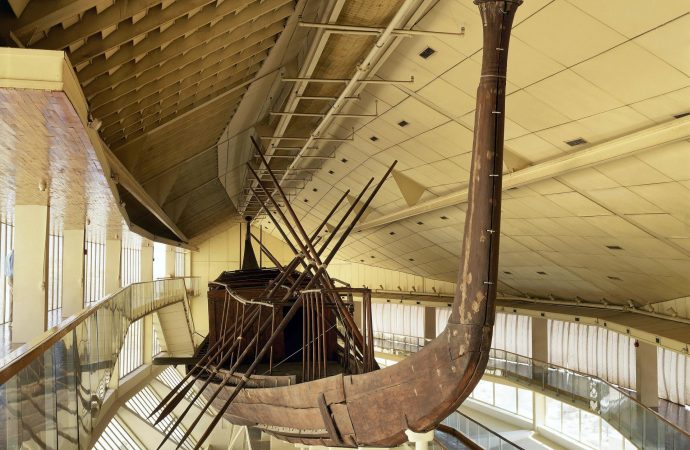By Mohamed Maher – 5 minutes read After being put on display in a special museum on Giza Plateau, just behind the Great Pyramid, the 4,600-year-old boat belonged to King Khufu has been transported to the Grand Egyptian Museum-GEM. A ritual vessel intended to carry the resurrected king is believed to have been made for
By Mohamed Maher – 5 minutes read

The smart, remote-controlled car carrying the boat
After being put on display in a special museum on Giza Plateau, just behind the Great Pyramid, the 4,600-year-old boat belonged to King Khufu has been transported to the Grand Egyptian Museum-GEM. A ritual vessel intended to carry the resurrected king is believed to have been made for the pharaoh Khufu, also known by his Greek name Cheops.
Media outlets were not invited to witness the transfer, as it was a precise and complicated process that could have been made more difficult by the presence of the press, said officials.
King Khufu is the owner of the Great Pyramid of Giza, the only standing and most ancient wonder of the seven wonders of the ancient world. Khufu’s first boat, known in the media as the solar boat. The boat was discovered in May 1954, by Kamal El Mallakh. It was found in a sealed pit by the Great Pyramid of Giza during an expedition to remove sand from the southern side of the Great Pyramid of King Khufu. It reportedly took more than a decade to piece the vessel back together, and much of that time was spent studying shipbuilding customs of ancient Egypt. After its restoration and reconstruction, the boat was then put on display in a museum bearing its name on Giza Plateau which, unfortunately, marred the beauty of the pyramid.
Many ideas to move Khufu’s boat were studied. All of them involved dismantling the boat and reconstructing it at the GEM. Such ideas proved risky, however, because this could be more dangerous than keeping the boat in its current location.
Moving the 42 meter long and 20-ton boat in one piece was the only suitable solution, like the transportation of Ramses II colossus from Ramses Square to the GEM.
In preparation for the transfer, the work team at the GEM and the Supreme Council of Antiquities (SCA) conducted three simulations during the past several months – using the smart, remote-controlled vehicle specially transported from Belgium – to test the vehicle’s performance moving of the boat, in order to ensure its safe arrival, which have proved successful. It took 10 hours to move the boat.
Preparing the Boat to be moved was a long process that began 24 hours ahead of the transfer itself, the tourism ministry said. The Boat was safely encased within a capsule bearing its name in gold, which was then hoisted onto the massive Belgian vehicle.
Golden Mummies Parade
This brings back the wonderful Royal Mummies Parade or Golden Parade that the whole world watched while holding their breath, where 22 mummies – 18 kings and four queens – were moved from the peach-color Egyptian Museum at Tahrir square through the streets of Cairo away to rest just right next to Giza Plateau, in the same place with the Solar boat of Khufu, the Grand Egyptian Museum-GEM.

King RamsesII in His Vehicle being moved to GEM
Each mummy was carried on a decorated vehicle fitted with special shock-absorbers and surrounded by a motorcade, including replica horse-drawn war chariots.
“The Ministry of Tourism and Antiquities has done its best to make sure that the mummies have been stabilized, conserved, and are packed in a climate-controlled environment,” said Salima Ikram, professor of Egyptology at the American University in Cairo.
Grand Egyptian Museum-GEM Parade
According to The Ministry of Tourism and Antiquities, the GEM is due to open in October, however the opening was delayed several times giving some political unrest between 2011 and 2017 and was delayed again due the COVID-19 global crisis.

Grand Egyptian Museum-GEM
The Museum will host more than 100,000 artifacts, making it the largest archaeological museum in the world dedicated to a single civilization. It covers an area of 480,000 square meters (5,200,000 sq ft), overlooking the Giza plateau.
Yes, true, it will be the world’s largest archeological museum and dedicated to one civilization, which is the most ancient and advanced civilization the history of mankind ever witnessed.
The location of the GEM was selected for many reasons, most importantly that it sits on a site west of the pyramids, near a motorway interchange. The building is shaped like a chamfered triangle in plan. The north and south walls of the building are lining up directly with the Great Pyramid of Khufu and the Pyramid of Men-kau-re. The new museum is designed to include the latest technology, including virtual reality.
Some of ancient Egypt’s most illustrious relics will be displayed, including the famed collection of King Tutankhamen, which has been moved in to the museum’s halls after a world tour that saw it displayed in Paris, London and Los Angeles.
Avenue of Sphinxes Parade
Preparations are underway for another major Pharaonic-themed event that will bring the world’s attention to Egypt, this time in Luxor. The reopening of the Avenue of Sphinxes. Yet, the exact time of the reopening is not set.
The Avenue of Sphinxes is a 2700-meters-long-paved-pathway (1.7 miles) flanked with two rows of sphinxes connects Luxor Temple to Karnak Complex in the city of Luxor, Egypt. The sphinxes are still under a sophisticated process of restoration. The Avenue has many types of statuary among its 1,200 statues, including many bearing ram features.

The Avenue of Sphinx’s at Luxor
In 1949, the Egyptian archaeologist Zakaria Ghoneim unearthed the first eight ram-headed statues. Over the decades, Egyptian archaeologists discovered the remains of the road following him.
The construction of the Avenue began during the New Kingdom (1550 BC-1070BC) and was completed during the 30th Dynasty rule of Nectanebo I (380-362 BC).
Mustafa El-Saghir, The Director of Karnak Temples and General Supervisor of the Grand Processional Way project said that the upcoming event will revive the celebration of The Opet. It was the most famous and important feast in ancient Egypt. It is dedicated to Amun and took place when the harvest season ends, between the second half of October and the first half of November.
“Opet Festival was held to honor the Thebes’ local trinity; Amun-Re along with his companion goddess Mut (lioness headed) and their son Khonsu. During that festival, there was a procession from Karnak Temple. Three statues representing these gods were placed in gilded barques and carried by priests along the Pathway to Luxor Temple and back,” he said.
“In the upcoming celebration, people representing priests will carry the statue of Amun from Karnak Temple, Mut’s from her temple and Khunsu’s as well on sacred boats, exactly like ancient Egyptians did,” he said, adding that lighting, Pharaonic attire, performances and music will add excitement to the modern festival.
















Leave a Comment
Your email address will not be published. Required fields are marked with *